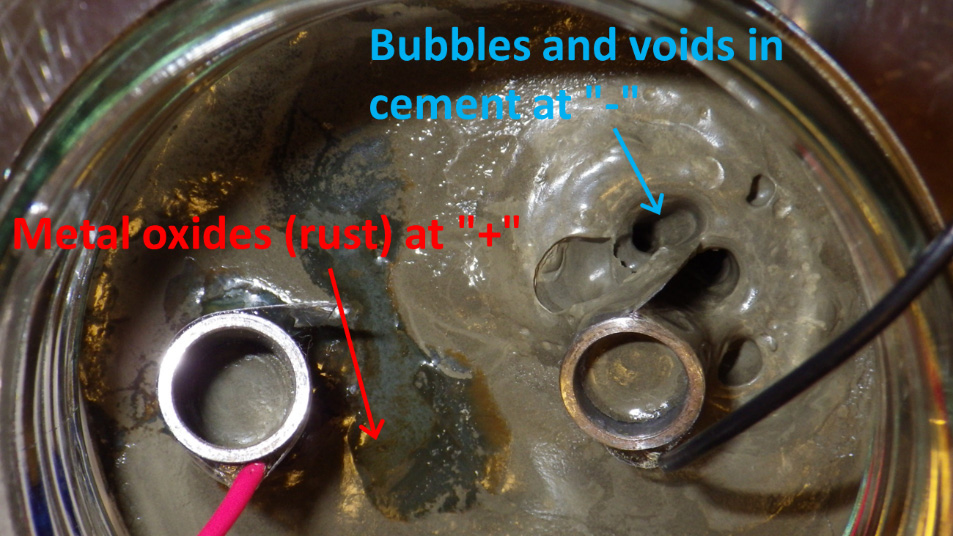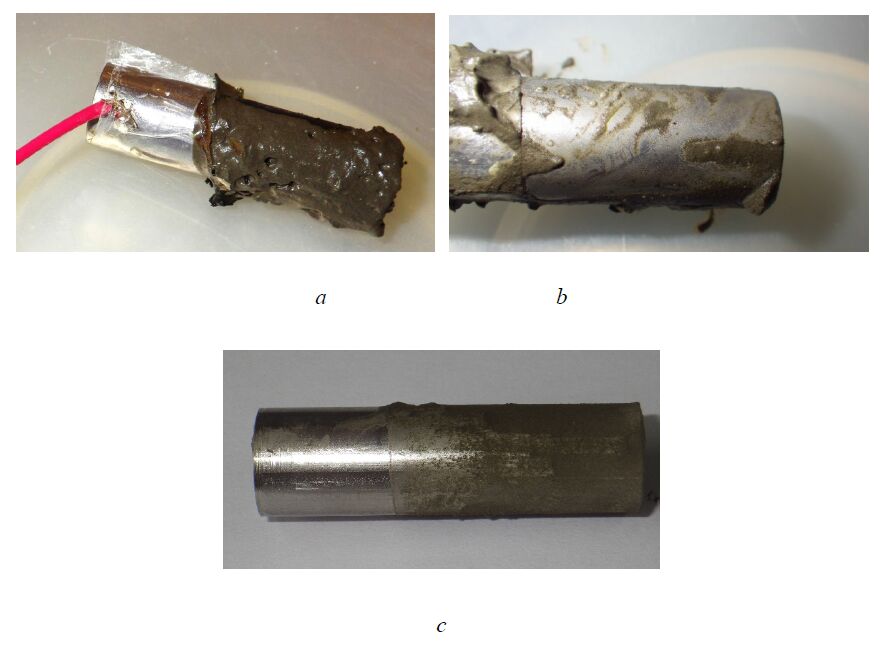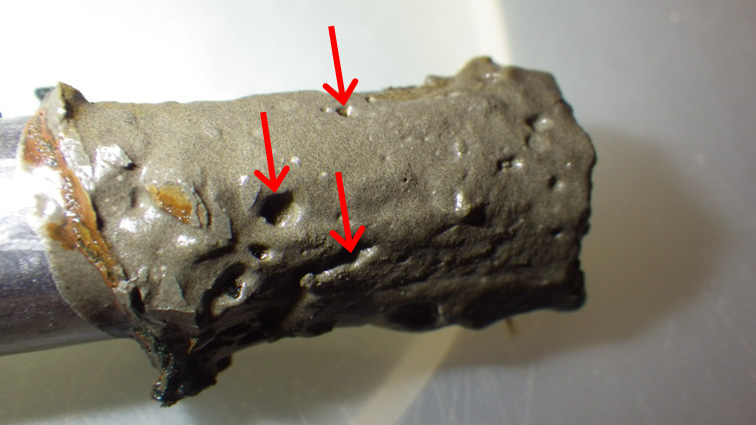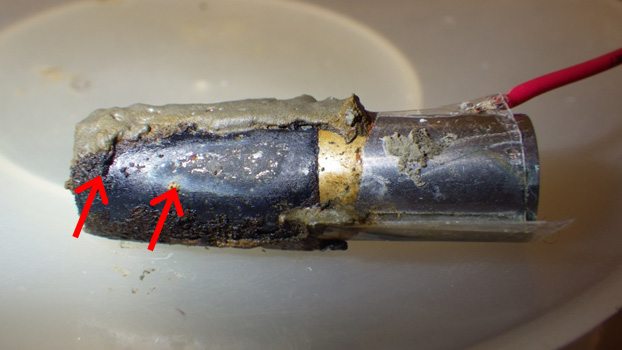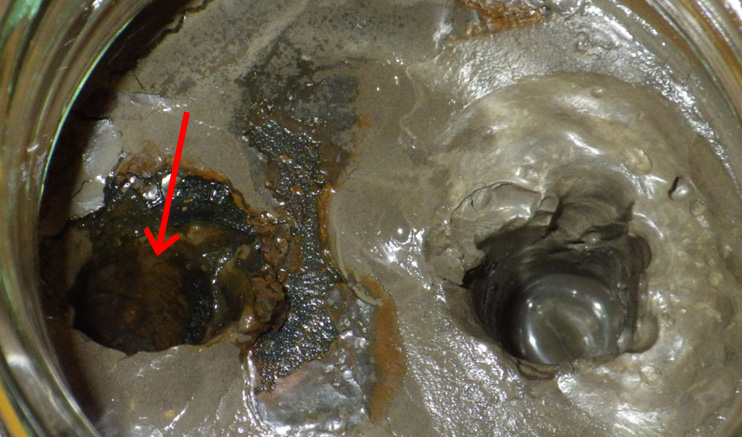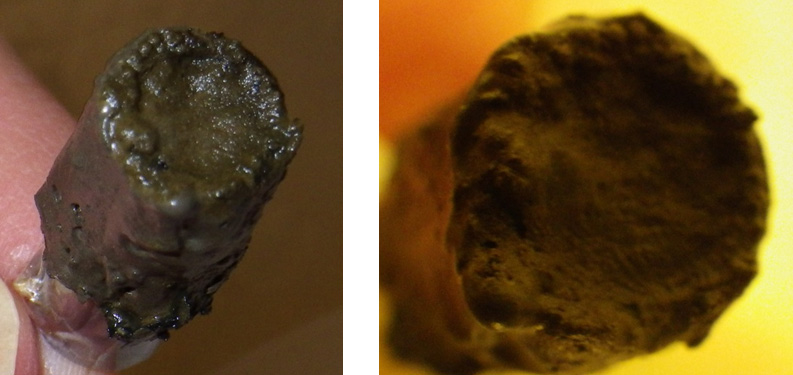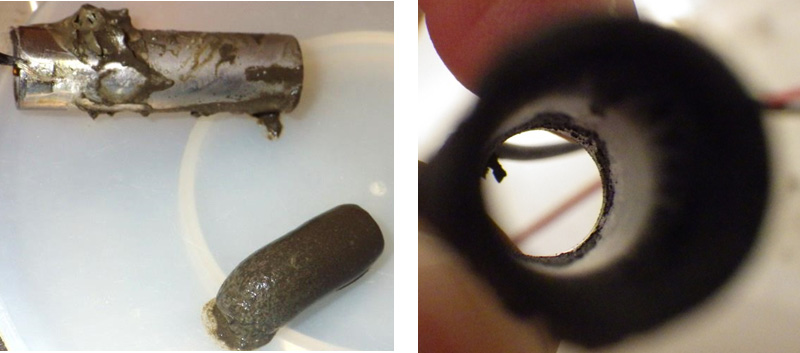1. Introduction
Shear bonding and hydraulic bonding between steel and cement are the key factors affecting well integrity in oil & gas industry, geothermal industry, and during underground CO2 storage. After a wellbore has been drilled to a certain depth, the drill string is pulled out of the hole, and a steel pipe called casing is run in. The annular space between the casing and the surrounding rock formation is then cemented by pumping a cement slurry from the bottom of the hole up the annulus. After solidification, the cement sheath provides mechanical support for the casing, isolates the casing from aggressive formation fluids, and ensures the zonal isolation [1]. Zonal isolation means that flow of formation fluids along the wellbore is prevented. If zonal isolation is violated, formation fluids, i.e. brine, oil, or gas, can migrate between geological strata along the well. In the worst case, it may lead to an underground blowout.
The ability of the cement sheath to provide zonal isolation requires that the cement permeability is sufficiently low. The permeability of bulk cement used in well construction is usually on the order of 10 µD or less, which is sufficiently low to ensure zonal isolation in most wells. However, if cement contains defects (cracks, voids, mud channels or gas channels), such defects, once linked up to each other, may establish a continuous flow path along the well [2]. This may significantly increase the effective permeability of the cement sheath. One particular type of defects in annular cement is associated with the interfaces between cement and the other materials exposed in the annulus, first and foremost the rock and the steel (casing).
Good shear/hydraulic bonding between cement and steel is therefore essential for long-term well integrity. This requires that (a) bonding has high quality after the cement set and (b) the interface can withstand shear and tensile stresses it may be exposed to during the lifetime of the well [3]. Improving the bonding strength can be attempted by using recent technological advances, e.g. various coatings, preparation of the casing surface, optimization of cement composition, etc. In this experimental study, we aim to investigate if the bonding between cement and casing could be improved by applying constant electric potential to the casing. Our laboratory experiment is based on the conjecture that solid particles in a cement slurry bear electric charge and therefore can be manipulated by electric field. This is similar to clay particles that are known to be negatively charged and therefore be easily manipulated by electric field (e.g. [4,5]). Applying constant electric field to a water-saturated clay leads to electrophoresis, whereby clay particles are accumulated at the positive electrode while water is accumulated at the negative electrode. Electrophoresis in a cement slurry is known as well and was previously used e.g. to evaluate the zeta-potential of cement particles [6]. The objective of our study is to investigate whether electrophoresis in cement slurry could be used to improve bonding between steel and cement.
2. Materials and Method
2.1. Preparation of cement sample
Portland G cement purchased from Norcem AS was mixed with tap water of Trondheim municipality quality with a water/cement mass ratio of 0.44. The slurry was hand-mixed for 3 minutes. This preparation procedure was sufficient for the purposes of this study. It should, however, be noted that specially designed additives are often included in cement formulations used in oilwell cementing (retarders, extenders, defoamers, fluid-loss control agents, etc.) [1]. No such additives were introduced in cement in this study because our goal was to prove, as a first step, that the effect of electric field on the bonding does exist in neat cement.
2.2. Application of voltage
After preparation, the cement slurry was poured into a glass container, and two electrodes were inserted into the slurry immediately after pouring (Figure 1). Each electrode was a piece of a steel pipe, 35 mm long and 10 mm in outer diameter. The thickness of the pipes was 1 mm. The electrodes were connected to two 9 V DC batteries joined in series. The voltage between the electrodes was thus equal to 18 V. The experiment was performed at room temperature and atmospheric pressure. The experiment was carried on for 18 minutes.
3. Results
During the 18-min exposure, gas bubbles were observed at the negative electrode. Around the positive electrode, corrosion products gradually emerged in the slurry (Figure 2). The gas released at the negative electrode was presumably mainly hydrogen. Bubble formation was continuous and created audible noise during the experiment.
After 18 minutes of exposure, the electrodes were carefully pulled out of the slurry. The slurry has become thicker by that time, but was still in a liquid state and could not significantly damage the cement bonded to the electrodes during pulling of the electrodes out of the container.
Visual examination of the electrodes revealed the following:
·bonding was significantly improved at the positive electrode (Figure 3a);
·there was virtually no bonding at the negative electrode (Figure 3b);
·some small voids (bubbles) were observed in the cement bonded to the positive electrode (Figure 4);
·part of cement was separated from the positive electrode, presumably because it was ripped off by bubbles (Figure 5);
·corrosion products were visible on the part of the positive electrode's exterior where cement was separated (Figure 5, arrows). Corrosion products were also visible in the hole left in the thickened cement slurry after removing the positive electrode (Figure 6).
Poor bonding at the negative electrode was likely due to negatively-charged cement particles being repelled from the pipe back into the slurry. Improved bonding at the positive electrode was due to the attraction of the particles to the electrode. The bonding at the positive electrode was so good that a cement column remained inside the pipe after the pipe was pulled out of the slurry (Figure 7). On the contrary, the cement column slid out of the pipe that was exposed to negative potential (Figure 8).
It should be noted that, based on this experiment only, there is still a possibility that the difference between bonding at the positive and the negative electrode be caused solely by poor bonding at the negative electrode. The latter could be e.g. due to gas formation (hydrogen) at the negative electrode, as discussed above. In order to confirm that bonding was indeed improved at the positive electrode, a reference test was performed. In this test, the pipe was immersed into the cement slurry for 18 min without applying electric field. The appearance of the pipe after 18 min of exposure was in between those obtained at the negative and positive electrodes (compare Figure 3c to Figures 3a and 3b). This confirms that applying positive potential to the pipe indeed improves bonding, as compared to the case without electric field.
4. Discussion
It was previously suggested to use electric field in drilling, to clean drill bits from clay particles [7]. In drilling, clay particles often stick to the bit, which may eventually lead to a drilling problem known as“bit balling”[8]. It results in reduced rate of penetration and, in the worst case, inability to drill. Since clay particles carry negative surface charge, applying negative potential to the drill bit was found to repel clay particles and mitigate bit balling. This improved the rate of penetration in shales (clay-rich sedimentary rocks) [7].
To the best of our knowledge, the experiment presented in this paper is the first observation of the effect that electrophoresis has on cement-steel bonding. Albeit being qualitative, our results suggest that there is a significant effect of constant electric potential on cement-steel bonding. This, potentially, could be used to improve the quality of cementing jobs in oil & gas, geothermal, and CO2-injection wells by applying positive potential to the casing string. However, corrosion and bubble formation at the positive electrode observed in our experiment may prevent such a straightforward deployment of the“electric casing”technology. In particular, bubbles formed near the positive-polarity casing surface would remain there after the set and would serve as stress concentrators during the life time of the well [9,10]. Hydrogen formed at the negative-polarity electrode would be also detrimental to the steel structures in the well since it promotes corrosion. In order to prevent corrosion and bubble formation detrimental to practical applications of electrophoresis for enhanced bonding, alternating or pulsing electric fields might be tried in future endeavors.
Real oilwell cements usually contain various chemicals designed to reduce flocculation. These chemicals operate by neutralizing the surface charge of cement particles. If the surface charge is neutralized completely, it might become difficult to move the particles by electric field. It is therefore important to investigate, in future, whether the effects observed in this preliminary study are still at play in such cements.
Bubble formation, if controlled, may result in a lightweight, porous cement. Such cements are sometimes advantageous, as long as their permeability remains sufficiently low. Therefore, another possible application of the“electric casing”technology could be manipulation of bulk properties of cement, in particular its void ratio. Here, again, corrosion of the pipe may impede practical application of the DC field.
Poor bonding at the negative electrode may be used to develop new methods of cleaning steel or, in general, metal surfaces in cement equipment. Pieces of equipment such as cement pumps, cement mixers, and cement tanks could be cleaned more efficiently by applying negative potential to the surface to be cleaned. Moreover, applying such potential during operation of the equipment may reduce sticking of the cement to the surfaces in the first place. These cleaning applications are free of the corrosion issues discussed above (compare the distribution of corrosion products between the holes left after the positive and the negative electrodes in Figure 6).
5. Conclusion
Experiments with electrophoresis of a cement slurry revealed that bonding of cement to steel is improved at the positive electrode and is virtually absent at the negative electrode. This may have significant application potential in oil & gas and construction industries, where it is necessary to improve cement bonding to steel casing or steel reinforcements. Corrosion observed at the positive electrode and bubble formation observed at the negative electrode (and less so at the positive one) may reduce the applicability of the DC field as used in our experiment. Other shapes of voltage vs. time can be tried to solve this problem.
Poor bonding at the negative electrode may be used to develop innovative technologies for cleansing of surfaces in cement equipment (cement pumps, tanks, mixers, etc.). In such applications, the bubble formation observed at the negative electrode might even be helpful.
Acknowledgment
The authors are grateful to the anonymous reviewer for useful comments and suggestions that helped to improve the manuscript, and in particular the suggestion to perform a reference test. This publication has been produced in the project“Closing the gaps in CO2 well plugging”funded by the Research Council of Norway (243765/E20). The project is administered as an integrated part of the BIGCCS Centre funded by Gassco, Shell, Statoil, Total, Engie and the Research Council of Norway (193816/S60).
Conflict of Interest
The authors declare no conflicts ofinterest regarding this paper.









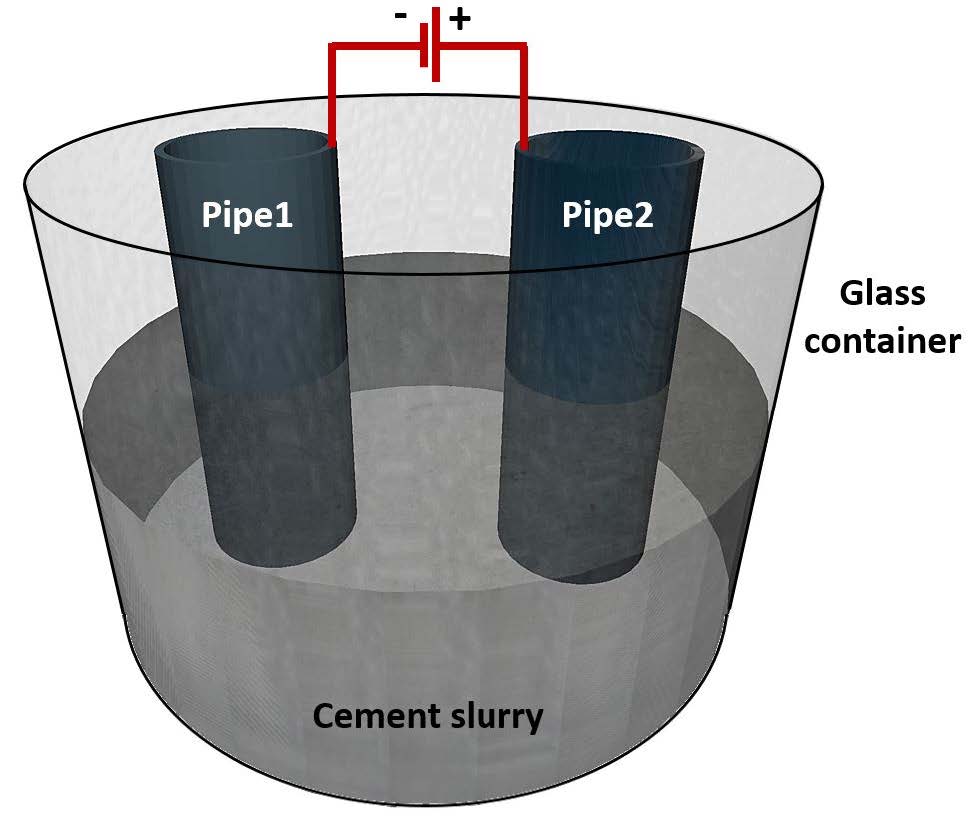
 DownLoad:
DownLoad: 